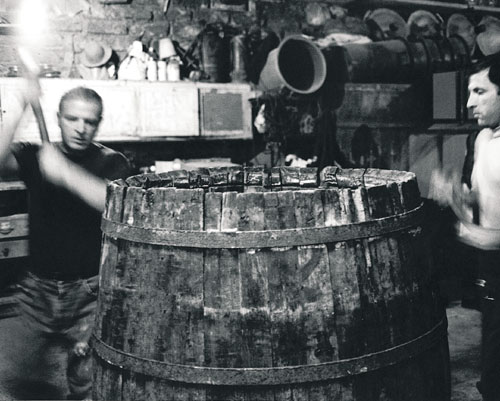|
Experimentum Mundi: playing with inherent acoustics
Andrew
Kettle

Experimentum
Mundi, photo by Stuart Morris
There was a full-house audience at the Powerhouse Theatre to see Experimentum Mundi last night. As the performance began, the auditorium was dim and the stage lit only by a single spotlight on a pile of wet mortar with a trowel protruding from its summit. There was a sudden darkening of the house lights and a corresponding hushing of the murmur of the audience as the artisans entered from both sides of the stage, taking their positions around the tables, workbenches and anvils, the narrator, conductor and percussionist completing the troupe.
At the right of the stage on a raised platform sat four black-clad women (Paola Calcagni, Ida Sannibale, Annarita Severini and Maria Rose Calcagni). Their whispering rose and fell following the gestures of the conductor (Giorgio Battistelli) who silenced them with a wave. Another slow, snaking gesture from Battistelli’s wrist, and the four women were metamorphosed into whispering village gossips. Throughout the performance, their cackling and murmuring rose and fell, at times lost in the noise of the artisans and their tools, never quite distinctly interpretable.
The narrator (Dennis Olsen) intoned from Diderot’s 16th Century Encyclopedie descriptions of the artisans, their trades, the materials they used and the tools they required. There were coopers and carpenters, a pasta maker and pavers, a mason, smiths, shoemakers and a grinder sharpening tools.
On the highest platform, overlooking the stage, the percussionist (Nicola Raffone) accompanied the artisans with a large array of instruments, reinforced their rhythms, building tension, setting the pace, adding complexity to the simple noises of the tools–although at times dominating the composition at the expense of the true musicians in this work.
Marcello di Palma, Pasta Maker, comically initiates the performance with egg cracking and beating. Sergio Leandri and Guido Salustri, Shoemakers, add leather preparation, sole tacking, leather trimming and polishing. The Pavers, Antonio Innocenzi and Oberdan Carpineti, contribute sand shifting, paver placement, hammering and levelling. Chips fly from the front of the stage as Fernando Carpineti wields his Stone Mason’s chisel.
After sitting in darkness for nearly half the show, the Grinders, Miro Carpineti and Aldo Sardilli, erupt into sound and the light of sparks, sharpening their knives on adapted cycle grinding wheels. The most dynamic were the Coopers, Alfredo and Gianni Sannibale, constructing a barrel, pounding the hoops and preparing the barrel’s interior. Masons Ciro Paudice and Maurizio Verdosci shovel and trowel mortar, lay and tap bricks to build a terracotta wall between the conductor and percussionist.
The "feast for the senses" promised in the programme was completed by the smoke from the Smiths’ coals eventually filling the theatre, literally reinforcing the atmosphere of a village setting. This is the romantic, Italian version of Einsturzende Neubauten–hammered metal, chiseled rock and all.
"The music of an Italian village" motif could be somewhat deceptive. The compromises in Experimentum Mundi, written in 1981, has the artisans teetering on the brink of pointless impracticality. Leandri’s and Salustri’s shoes and Palma’s pasta have practicality, starkly contrasting with Tamburri’s and Casini’s aimless sawing, chiseling and planing and Smiths’ Paudice and Verdosci pounding cold iron and anvil. Undoubtedly Sannibale’s and Borgiani’s cobbled-together wall, Sannibale’s barrel and Innocenzi’s and Carpeti’s pavers will be dismantled, ready to be reassembled for the next performance. Perhaps over the five performance season, Carpeti’s stone may evolve into something.
While Battistelli intends to pay tribute to the fast disappearing skills of "real life" artisans, he may inadvertently be doing them a serious disservice by appearing to deprive them of their pride in actual work and their labour ethic. The show’s programme is dominated by the biographical details of composer and narrator, relegating the names of the artisans to the credits listed on the back cover.
However, bringing together artisans from Battistelli’s home town, capturing the inherent acoustic of the materials and tools to combine them in charming, powerful and playful relationships, whilst retaining a poetic simplicity, was worthy of the enthusiastic applause this performance received. The rush of audience members to explore the stage was testimony to the audience’s hunger for more.
Experimentum Mundi
Opera di musica immaginistica
Powerhouse Theatre, Brisbane Powerhouse
July 20

|
